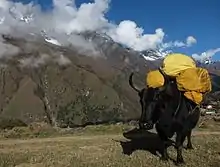Dzo
A dzo (also spelled zo, zho and dzho, Standard Tibetan: མཛོ་, romanized: mdzo) is a hybrid between the yak and domestic cattle. The word dzo technically refers to a male hybrid, while a female is known as a dzomo or zhom. In Mongolian, it is called a khainag (хайнаг). There is also the English language portmanteau term of yattle, a combination of the words yak and cattle,[1] as well as yakow,[2][3] a combination of the words yak and cow.
| Dzo | |
|---|---|
 | |
| A dzo acting as a pack animal en route to Mount Everest | |
Domesticated | |
| Scientific classification | |
| Domain: | Eukaryota |
| Kingdom: | Animalia |
| Phylum: | Chordata |
| Class: | Mammalia |
| Order: | Artiodactyla |
| Family: | Bovidae |
| Subfamily: | Bovinae |
| Tribe: | Bovini |
| Genus: | Bos |
| Species: | |
Dzomo are fertile (or, fecund) while dzo are sterile. As they are a product of the hybrid genetic phenomenon of heterosis (hybrid vigor), they are larger and stronger than yak or cattle from the region.[4] In Mongolia and Tibet, khainags are thought to be more productive than cattle or yaks in terms of both milk and meat production.[5][6]
Dzomo can be back crossed. As a result, many supposedly pure yak or pure cattle probably carry each other's genetic material. In Mongolia, the result of a khainag crossed with either a domestic bull or yak bull is called ortoom (ортоом, three-quarter-bred) and an ortoom crossed with a domestic bull or yak bull results in a usan güzee (усан гүзээ, one-eighth-bred).[6][7]
Dzo inherit two different types of proteins, one from each parent, and their mitochondrial structure and function changes.[8] This significantly changes the dzo's ability to survive in higher altitudes than both parents can.
See also
- Bovid hybrid
- Yakalo, a yak/buffalo (American bison) hybrid
References
- Mummolo, Jonathan (August 11, 2007). "Yattle What?". The Washington Post. Retrieved January 3, 2017.
Mentzer, who grew up farming in Loudoun County, and his partner, Jim Dumbrell, a retired British oil and gas pipeline consultant, are breeding yattle -- a cross between cows and yaks.
- National Research Council (1983). Little-Known Asian Animals With a Promising Economic Future. Washington, D.C.: The National Academies Press. p. 34. doi:10.17226/19514. ISBN 978-0-309-32715-2.
- Mason, Ian (March 2002). Porter, Valerie (ed.). Mason's World Dictionary of Livestock Breeds, Types and Varieties. West Sussex: CABI. p. 122. ISBN 085199430X.
- David B. Madsen; Fa-Hu Chen; Xing Gao (3 July 2007). Late Quaternary Climate Change and Human Adaptation in Arid China. Elsevier. p. 207. ISBN 978-0-444-52962-6.
- Bataagiin Bynie: Mongolia: The Country Refort (sic!) On Animal Genetic Resources, Ulaanbaatar 2002, p. 11
- Tsering, Diki (2002). Dalai Lama, My Son. Penguin Books. ISBN 0-7865-2260-7.
- Takase Hisabumi, Kh. Tumennasan et al., "Fertility Investigation in F1 Hybrid and Backcross Progeny of Cattle (Bos taurus) and Yak (Bos gruniens) in Mongolia: II. Little variation in gene products studied in male sterile and fertile animals", in: Niigata journal of health and welfare Vol. 2, No. 1, pp. 42–52.
- Long, L., Zhu, Y., Li, Z., Zhang, H., Liu, L., & Bai, J. (2020). Differential expression of skeletal muscle mitochondrial proteins in yak, dzo, and cattle: a proteomics-based study. The Journal of veterinary medical science, 82(8), 1178–1186. https://doi.org/10.1292/jvms.19-0218
External links
 Media related to Dzo at Wikimedia Commons
Media related to Dzo at Wikimedia Commons- dictionary.com
 The dictionary definition of dzo at Wiktionary
The dictionary definition of dzo at Wiktionary